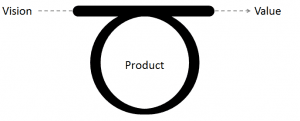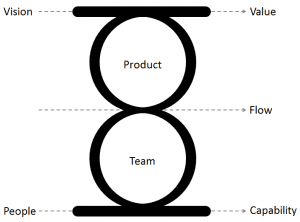I wrote this short article for JAX Magazine, but it seems JAX doesn’t want to make it easy for people to access the content (you have to register to get a download link which only works once). So I’ve decided to post the article here as well. Its an evolution of some of my thinking that goes back to the new lean and agile picture I posted.
One of the value statements from the Agile Manifesto is “individuals and interactions over processes and tools”. This is often abbreviated to “people over process” with a common interpretation being that the human aspects of software development are the primary areas we should be focussing on for improvement. However, this is counter to the ideas of W. Edwards Deming, who said “a bad process will beat a good person every time”. Similarly, Don Reinertsen has said he prefers “people times process” because if either is zero, then the product is zero.
People and process are two sides of the same coin, both equally important in understanding how to improve capability to deliver valuable software.
People
This side of the coin is about taking a group of people, who form a team in order to develop a capability. Peter Senge wrote in ‘The Fifth Discipline’ that “the fundamental learning units in an organisation are working teams (people who need one another to produce an outcome)”. Creating teams in this way allows people to iteratively learn about the way that they work so that they can incrementally develop their capability in order to improve the outcomes that they produce.
This is the basis of all the popular Agile methods such as Scrum or Extreme Programming, which all recommend creating cross-functional and co-located teams, collaborating with high bandwidth communication. Thus, the people side suggests that forming outcome-focussed teams, rather than activity-focussed silos, will result in an improvement.
 Process
Process
This side of the coin is about taking a vision, which is developed into a product in order to deliver value. Mark Denne and Jane Cleland-Huang wrote in their book ‘Software by Numbers’ about “an ROI-informed approach to software development in which software is developed and delivered in carefully prioritized chunks of customer valued functionality”. Taking this approach means that a product will maximise its value through being iteratively refined piece by piece in order to incrementally deliver functionality.
This is the basis of Lean approaches such as Kanban, which focuses on creating an explicit understanding of the process in order to learn how to deliver valuable pieces of software more effectively by modelling and visualising the work and associated policies. Concepts such as Minimal Marketable Features and User Stories help break down the work into smaller pieces. Thus, the process side suggests that continuously delivering small pieces of functionality with minimal delays, rather than waiting to release large batches of features, will result in an improvement.
People and Process
It is when we put these two sides together that we can achieve significant improvement. The iterative loops of learning about both the team and the product link into each other enable product value to rapidly flow through capability teams. This is the development nirvana we are trying to reach.
This model also gives some insight into why the “Waterfall” model, described by Winston Royce in his 1970 paper ‘Managing the Development of Large Software Systems’, has proved to be unsuccessful. It is not because the simple work-flow described was inherently wrong, but because the work-flow has typically been implemented with specialist silos rather than capability teams, and with large rather than small batches. It is both these two sides of the coin that should be the focus of learning and improvement in order to help us on our journey to the nirvana of product development flow.


 Process
Process

Good insight and well presented. This article has lots of potential for future work.
“However, this is counter to the ideas of W. Edwards Deming, who said “a bad process will beat a good person every time”.”
I do not believe this is a quote from Deming, but rather paraphrasing a quote from Dr. Geary Rummler
Please provide a source for the Deming quote
Thanks Cherie. I wasn’t aware of that. Do you have a source for Rummler?